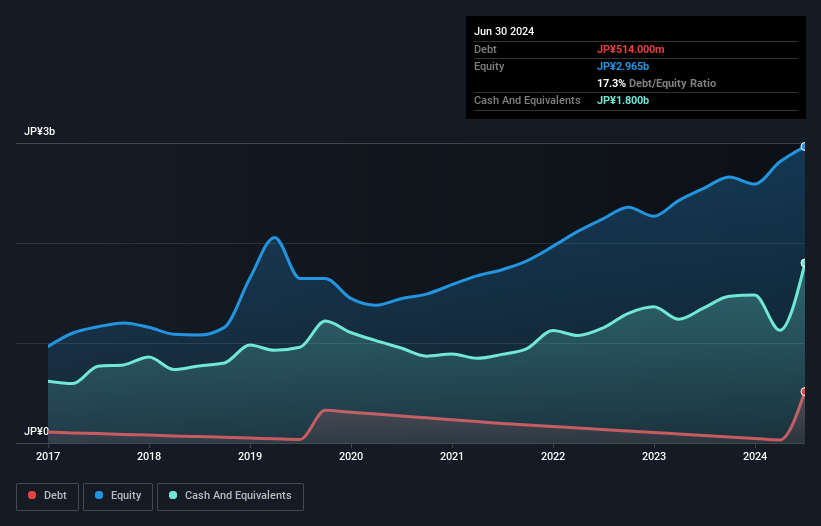Some say volatility, rather than debt, is the best way to think about risk as an investor, but Warren Buffett famously said that 'Volatility is far from synonymous with risk.' So it might be obvious that you need to consider debt, when you think about how risky any given stock is, because too much debt can sink a company. We note that JIG-SAW INC. (TSE:3914) does have debt on its balance sheet. But the more important question is: how much risk is that debt creating?
Why Does Debt Bring Risk?
Debt and other liabilities become risky for a business when it cannot easily fulfill those obligations, either with free cash flow or by raising capital at an attractive price. If things get really bad, the lenders can take control of the business. While that is not too common, we often do see indebted companies permanently diluting shareholders because lenders force them to raise capital at a distressed price. By replacing dilution, though, debt can be an extremely good tool for businesses that need capital to invest in growth at high rates of return. The first step when considering a company's debt levels is to consider its cash and debt together.
See our latest analysis for JIG-SAW
What Is JIG-SAW's Net Debt?
The image below, which you can click on for greater detail, shows that at June 2024 JIG-SAW had debt of JP¥514.0m, up from JP¥75.0m in one year. But it also has JP¥1.80b in cash to offset that, meaning it has JP¥1.29b net cash.

How Healthy Is JIG-SAW's Balance Sheet?
We can see from the most recent balance sheet that JIG-SAW had liabilities of JP¥1.17b falling due within a year, and liabilities of JP¥406.0m due beyond that. On the other hand, it had cash of JP¥1.80b and JP¥1.16b worth of receivables due within a year. So it can boast JP¥1.38b more liquid assets than total liabilities.
This short term liquidity is a sign that JIG-SAW could probably pay off its debt with ease, as its balance sheet is far from stretched. Simply put, the fact that JIG-SAW has more cash than debt is arguably a good indication that it can manage its debt safely.
Fortunately, JIG-SAW grew its EBIT by 7.7% in the last year, making that debt load look even more manageable. There's no doubt that we learn most about debt from the balance sheet. But it is JIG-SAW's earnings that will influence how the balance sheet holds up in the future. So if you're keen to discover more about its earnings, it might be worth checking out this graph of its long term earnings trend.
Finally, a business needs free cash flow to pay off debt; accounting profits just don't cut it. JIG-SAW may have net cash on the balance sheet, but it is still interesting to look at how well the business converts its earnings before interest and tax (EBIT) to free cash flow, because that will influence both its need for, and its capacity to manage debt. During the last three years, JIG-SAW produced sturdy free cash flow equating to 75% of its EBIT, about what we'd expect. This free cash flow puts the company in a good position to pay down debt, when appropriate.
Summing Up
While we empathize with investors who find debt concerning, you should keep in mind that JIG-SAW has net cash of JP¥1.29b, as well as more liquid assets than liabilities. The cherry on top was that in converted 75% of that EBIT to free cash flow, bringing in JP¥505m. So we don't think JIG-SAW's use of debt is risky. Above most other metrics, we think its important to track how fast earnings per share is growing, if at all. If you've also come to that realization, you're in luck, because today you can view this interactive graph of JIG-SAW's earnings per share history for free.
If you're interested in investing in businesses that can grow profits without the burden of debt, then check out this free list of growing businesses that have net cash on the balance sheet.
New: Manage All Your Stock Portfolios in One Place
We've created the ultimate portfolio companion for stock investors, and it's free.
• Connect an unlimited number of Portfolios and see your total in one currency
• Be alerted to new Warning Signs or Risks via email or mobile
• Track the Fair Value of your stocks
Have feedback on this article? Concerned about the content? Get in touch with us directly. Alternatively, email editorial-team (at) simplywallst.com.
This article by Simply Wall St is general in nature. We provide commentary based on historical data and analyst forecasts only using an unbiased methodology and our articles are not intended to be financial advice. It does not constitute a recommendation to buy or sell any stock, and does not take account of your objectives, or your financial situation. We aim to bring you long-term focused analysis driven by fundamental data. Note that our analysis may not factor in the latest price-sensitive company announcements or qualitative material. Simply Wall St has no position in any stocks mentioned.
About TSE:3914
JIG-SAW
A software technology company, provides IoT data control services in Japan.
Flawless balance sheet with questionable track record.
Market Insights
Weekly Picks

Solutions by stc: 34% Upside in Saudi's Digital Transformation Leader


The AI Infrastructure Giant Grows Into Its Valuation
Recently Updated Narratives

Perdana Petroleum Berhad is a Zombie Business with a 27.34% Profit Margin and inflation adjusted revenue Business
Many trends acting at the same time


Engineered for Stability. Positioned for Growth.
Popular Narratives


MicroVision will explode future revenue by 380.37% with a vision towards success


NVDA: Expanding AI Demand Will Drive Major Data Center Investments Through 2026



